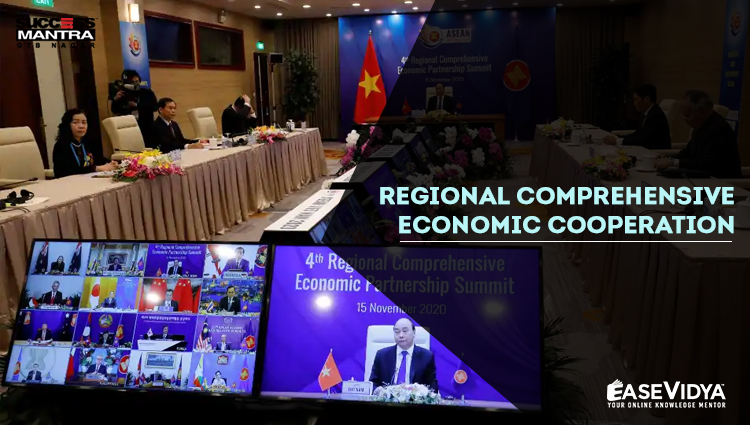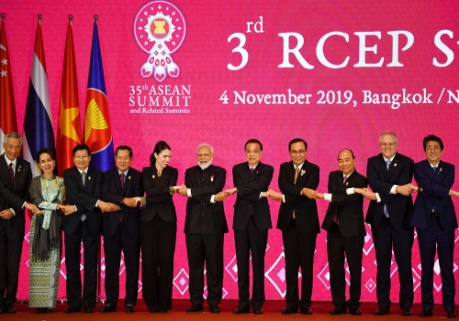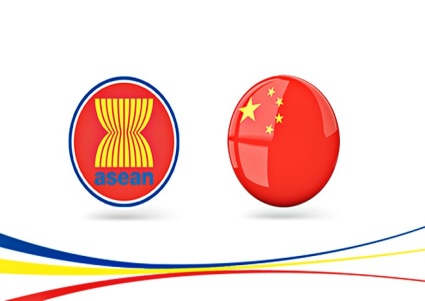
REGIONAL COMPREHENSIVE ECONOMIC COOPERATION
REGIONAL COMPREHENSIVE ECONOMIC COOPERATION (RCEP)
Recently, the Regional Comprehensive Economic Partnership (RCEP) has come into existence on the sidelines of the 37th ASEAN Summit. It has laid down the path for restarting discussion that had failed to admit India earlier and said “new” developments would be taken into consideration if India re-applies.
ORIGIN AND GENESIS OF RCEP

During the 19th ASEAN meeting in November 2011, RCEP was introduced and in November 2012, RCEP negotiations were launched at the ASEAN Summit in Cambodia. Regional Comprehensive Economic Partnership (RCEP) is a proposed agreement between the 10 members of ASEAN (the Association of Southeast Asian Nations)-- Brunei, Cambodia, Indonesia, Laos, Malaysia, Myanmar, the Philippines, Singapore, Thailand, and Vietnam, and 5 ASEAN's FTA partners (Free Trade Agreement)--Australia, China, Japan, New Zealand, and South Korea. India was also a member of ASEAN's FTA partner but opted out in November 2019.
Members of the RCEP make up nearly a third of the world's population and account for 29% of global gross domestic product (GDP). The China-backed group will emerge as the largest free trade agreement (FTA) in the world surpassing both the US-Mexico-Canada Agreement and the European Union (EU). It is expected to eliminate a range of tariffs on imports within 20 years and also includes provisions on intellectual property, telecommunications, financial services, e-commerce and professional services.
Under RCEP, any member nation would be treated equally, which might give companies in RCEP countries an incentive to look within the trade region for suppliers. Businesses with global supply chains might face tariffs even within an FTA because their products contain components that are made elsewhere. The deal could increase global national income by USD 186 billion annually by 2030 and add 0.2% to the economy of its member states. However, some analysts think the deal is likely to benefit China, Japan and South Korea more than other member states.
AIM OF RCEP
• The main aim of the RCEP is to create an integrated market with its member countries to make easier availability of goods and services across these regions. The negotiations are-- Trade in goods and services, investment, intellectual property, dispute settlement, e-commerce, small and medium enterprises, and economic cooperation.
WHY INDIA OPTED OUT FROM RCEP?
• India was of the view that its industries won't be able to compete with China as cheaper Chinese goods will flood Indian markets. Also, Indian agriculture was at risk because it would not be able to compete on a global scale. Additionally, between 2014-19, Modi government raised import duties on several products. Prime Minister Modi stated that when he measurement with the RCEP Agreement with respect to the interests of all Indians, he do not get a positive answer. He further stated that neither the Talisman of Gandhi-ji nor his own conscience permits him to join RCEP. Therefore, India opted out in November 2019.
• China is the major concern for India amongst other RCEP members. This is because China uses its non-tariff barriers so that it may export more products to different countries. For instance, if India increases the import duty on goods from China, it stops direct export to India and sends it goods to India via the countries in South-east Asia. Also, China doesn't import many goods from India. This raises India's concern over joining the RCEP.
SIGNIFICANCE OF RCEP FOR CHINA

• The beginning of RCEP is a major development that will help China and trade in the Asia-Pacific region in the post-Covid-19 scenario. It will give China access to Japanese and South Korean markets in a big way, as the three countries have not yet agreed on their FTA. While China already has a number of bilateral trade agreements, this is the first time it has signed up to a regional multilateral trade pact. While addressing the ASEAN Summit, India highlighted the necessity for peace and stability in the region but maintained silence regarding RCEP as it is not very welcoming of the China-backed grouping in the light of the ongoing military tension in eastern Ladakh along the Line of Actual Control (LAC).
• In the meantime, India held Malabar Exercise with Japan and the USA for the Quadrilateral Security Dialogue (QUAD) which was interpreted as an anti-China move. However, these moves did not influence Japanese and Australian plans regarding RCEP. India ended negotiation on RCEP over terms that were perceived to be against its interests. One of the major concerns for India was inadequate protection against surges in imports as its industry had fears that signing RCEP would allow cheaper products from China to flood the market in India. The extended power to China could lead to actions and incidents eroding trust in the maritime region disrespecting the territorial integrity and sovereignty. For example, the ongoing tensions at LAC and Chinese activities in Pakistan-occupied Kashmir.
• RCEP on India’s Membership: India, as an original negotiating participant of the RCEP, has the option of joining the agreement without having to wait 18 months as stipulated for new members in the terms of the pact. RCEP signatory states plan to commence negotiations with India once it submits a request of its intention to join the pact "in writing", and it may participate in meetings as an observer prior to its accession.
CONCLUSION
The mega trade bloc is a landmark trade initiative which is expected to boost commerce among the member-countries spread across the Asia-Pacific region. India needs to keep its interests on the table as the road to further expansion of its exports to RCEP member nations is very much still open, given that India already has trade and investment agreements with 12 of them. Utilizing existing agreements better while proactively exploring new opportunities in other geographies will diversify both Indian markets as well as an export basket.
QUESTIONS (1-5)
Q.1 Regional Comprehensive Economic Partnership (RCEP) is a proposed agreement between the 10 member nations of which of the following Associations or Organization?
A. Shanghai Cooperation Organization
B. ASEAN: ANSWER
C. BIMSTEC
D. European Union
Q.2 During which of the following summits of ASEAN does the Regional Comprehensive Economic Cooperation was introduced?
A. 15th ASEAN summit
B. 17th ASEAN summit
C. 19th ASEAN summit: ANSWER
D. 25th ASEAN summit
Q.3 Which of the following countries are currently the members of RCEP other than ASEAN nations?
A. China
B. Japan
C. South Korea
D. All of the above: ANSWER
Q.4 Which of the following statements is/are correct in the context of RCEP?
A. RCEP is viewed as an alternative to the Trans-Pacific Partnership (TPP).
B. RCEP is a proposed free trade agreement (FTA) between the ten member states of the ASEAN.
C. India joined RCEP as a member in 2012.
D. Both 1 & 2: ANSWER
Q.5 Which of the following countries is not the member Regional Comprehensive Economic cooperation as it withdrew itself from Trans-Pacific Partnership in 2017?
A. India
B. United States of America: ANSWER
C. France
D. Canada












0 Comment